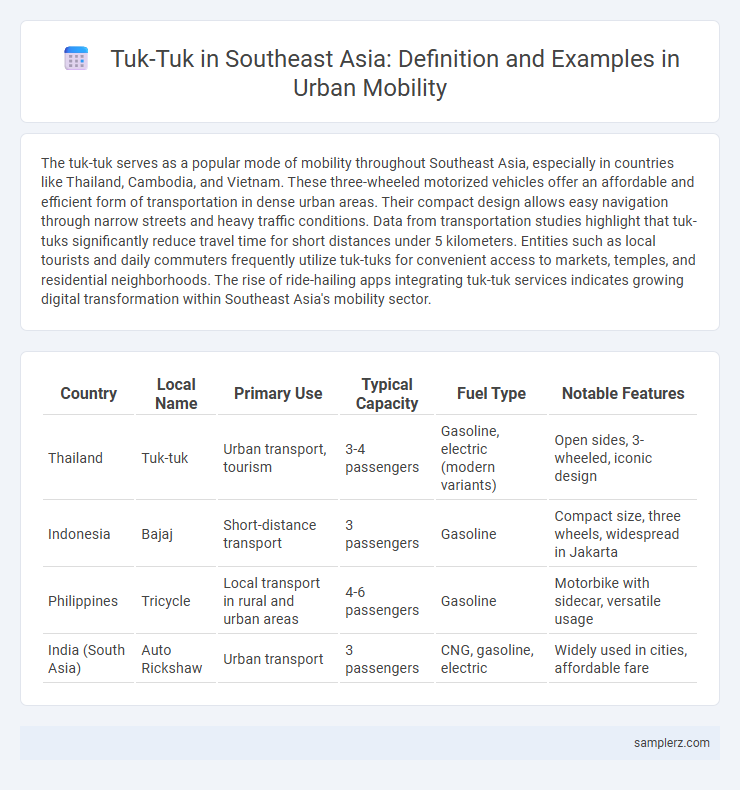The tuk-tuk serves as a popular mode of mobility throughout Southeast Asia, especially in countries like Thailand, Cambodia, and Vietnam. These three-wheeled motorized vehicles offer an affordable and efficient form of transportation in dense urban areas. Their compact design allows easy navigation through narrow streets and heavy traffic conditions. Data from transportation studies highlight that tuk-tuks significantly reduce travel time for short distances under 5 kilometers. Entities such as local tourists and daily commuters frequently utilize tuk-tuks for convenient access to markets, temples, and residential neighborhoods. The rise of ride-hailing apps integrating tuk-tuk services indicates growing digital transformation within Southeast Asia's mobility sector.
Table of Comparison
| Country | Local Name | Primary Use | Typical Capacity | Fuel Type | Notable Features |
|---|---|---|---|---|---|
| Thailand | Tuk-tuk | Urban transport, tourism | 3-4 passengers | Gasoline, electric (modern variants) | Open sides, 3-wheeled, iconic design |
| Indonesia | Bajaj | Short-distance transport | 3 passengers | Gasoline | Compact size, three wheels, widespread in Jakarta |
| Philippines | Tricycle | Local transport in rural and urban areas | 4-6 passengers | Gasoline | Motorbike with sidecar, versatile usage |
| India (South Asia) | Auto Rickshaw | Urban transport | 3 passengers | CNG, gasoline, electric | Widely used in cities, affordable fare |
The Rise of Tuk-Tuks: A Symbol of Southeast Asian Mobility
Tuk-tuks represent a vital mode of urban transportation across Southeast Asia, facilitating affordable and efficient travel in densely populated cities like Bangkok, Jakarta, and Manila. Their compact size and maneuverability allow easy navigation through congested streets, reducing commute times and supporting local economies by providing jobs for millions of drivers. As electric tuk-tuks gain popularity, they contribute to sustainable urban mobility by lowering emissions and promoting green transportation solutions in the region.
Historical Origins of Tuk-Tuks in Southeast Asia
Tuk-tuks originated in Southeast Asia in the mid-20th century as modified motorized rickshaws designed for efficient urban transport. Their popularity surged due to affordability, maneuverability in congested streets, and cultural adaptation from traditional cycle rickshaws. Countries like Thailand and Indonesia played pivotal roles in evolving the tuk-tuk into a symbol of local mobility and tourism.
Key Features of Tuk-Tuks: Design and Functionality
Tuk-tuks in Southeast Asia feature a compact, three-wheeled design optimized for navigating narrow urban streets and heavy traffic, offering agile maneuverability. Their open-sided cabins provide ventilation and easy passenger access, while the lightweight chassis ensures fuel efficiency and cost-effective operation. Typically powered by small-displacement engines or electric motors, tuk-tuks balance functionality with environmental considerations in densely populated cities.
Popular Tuk-Tuk Routes Across Major Southeast Asian Cities
Popular tuk-tuk routes across major Southeast Asian cities include Bangkok's bustling Khao San Road, where colorful tuk-tuks navigate lively streets filled with tourists and street vendors. In Phnom Penh, tuk-tuks commonly travel between the Royal Palace and the Central Market, offering quick access to key cultural sites. Singapore's Little India area also features tuk-tuk services providing an authentic and convenient way to explore vibrant neighborhoods and local eateries.
Tuk-Tuks vs. Other Local Transport: A Comparative Study
Tuk-tuks in Southeast Asia offer a unique blend of affordability, maneuverability, and cultural appeal compared to other local transport options like buses and motorcycles. Their compact size enables them to navigate narrow streets and congested urban areas more efficiently, providing quicker last-mile connectivity. Despite lower passenger capacity, tuk-tuks remain popular for short-distance trips due to their accessibility and cost-effectiveness in densely populated cities.
Environmental Impact: Tuk-Tuks and Urban Sustainability
Tuk-tuks in Southeast Asia contribute to urban sustainability by offering a low-emission alternative to traditional taxis, reducing air pollution in congested city centers. Electric tuk-tuks, increasingly adopted in cities like Bangkok and Ho Chi Minh City, lower carbon footprints and decrease noise levels compared to gasoline-powered versions. This shift supports cleaner urban mobility, aligning with regional goals for sustainable transportation and improved public health.
Electric Tuk-Tuks: Innovations in Eco-Friendly Mobility
Electric tuk-tuks in Southeast Asia exemplify groundbreaking advancements in eco-friendly urban mobility by reducing emissions and noise pollution compared to traditional gasoline models. These vehicles incorporate lithium-ion battery technology, regenerative braking systems, and solar power integration, enhancing energy efficiency and operational range. Governments and private sectors increasingly support electric tuk-tuk adoption through subsidies, charging infrastructure development, and sustainable transportation policies.
Tuk-Tuks in Tourism: Enhancing Traveler Experiences
Tuk-tuks in Southeast Asia serve as iconic, affordable transportation that enhances tourism by offering travelers an immersive cultural experience and easy access to local attractions. These three-wheeled vehicles provide convenient navigation through narrow streets and bustling markets, allowing tourists to explore cities like Bangkok, Phnom Penh, and Ho Chi Minh City efficiently. The vibrant, colorful design of tuk-tuks also adds to their appeal, making them a popular choice for photo opportunities and authentic urban adventures.
Government Policies Regulating Tuk-Tuk Operations
Government policies regulating tuk-tuk operations in Southeast Asia vary widely, with countries like Thailand implementing strict licensing systems and emissions standards to control environmental impact and enhance safety. In cities such as Bangkok, authorities enforce designated zones and operating hours for tuk-tuks to reduce traffic congestion and improve urban mobility. Local governments also mandate regular vehicle inspections and driver training programs to ensure compliance with public transportation regulations and promote sustainable urban transit solutions.
The Future of Tuk-Tuks in Southeast Asian Urban Transport
Electric tuk-tuks are rapidly transforming urban transport in Southeast Asia by reducing emissions and lowering operational costs. Governments in countries like Thailand and Indonesia are investing in infrastructure to support electric vehicle adoption, promoting sustainable mobility solutions. Integration of smart technologies in tuk-tuks enhances real-time navigation and passenger safety, positioning them as key players in future urban mobility ecosystems.

example of tuk-tuk in Southeast Asia Infographic
 samplerz.com
samplerz.com